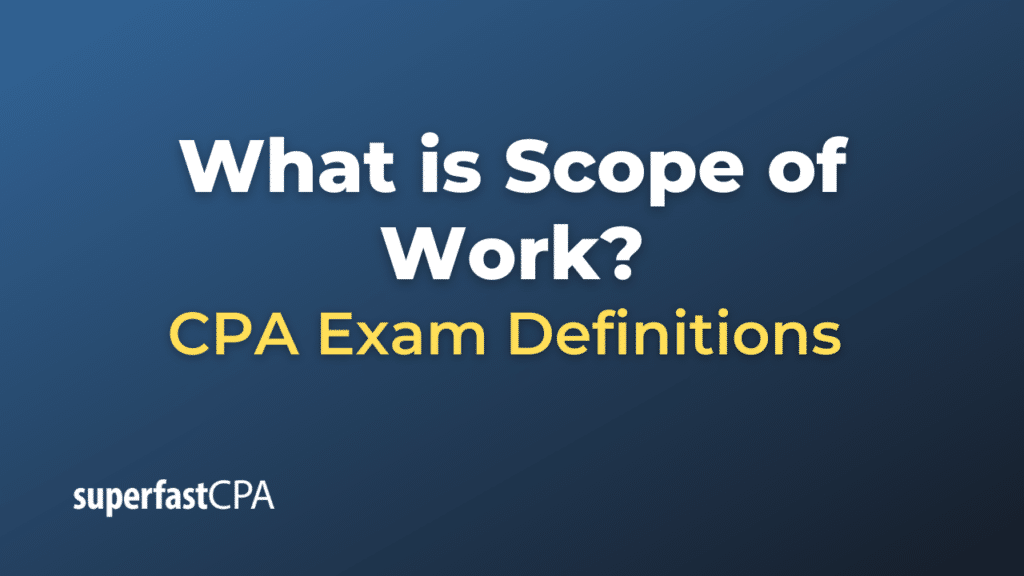Scope of Work
The “Scope of Work” (often abbreviated as SOW) is a document or a section of a document that clearly defines the boundaries of a particular project or contract. It lays out the specific tasks, deliverables, timelines, responsibilities, and standards related to a project. By setting clear expectations for both parties (typically a service provider and a client), the SOW helps prevent misunderstandings, miscommunications, and disputes over what was agreed upon.
Key components of a Scope of Work include:
- Project Overview: A brief description of the project, its purpose, and objectives.
- Deliverables: Specific outcomes or products that will be provided upon project completion. This could include reports, physical products, software, training sessions, and more.
- Tasks: The activities that need to be performed to produce the deliverables. It’s often a detailed list of every step that needs to be taken from the start to finish of the project.
- Timeline: A schedule that outlines when each task or deliverable is due. This could be presented as a list of dates or a Gantt chart.
- Milestones: Key events or stages in the project, marking significant progress.
- Payment Schedule: How and when the service provider will be compensated. This could be tied to the delivery of specific milestones or deliverables.
- Standards and Benchmarks: The quality criteria that the deliverables must meet, ensuring that the work is of an agreed-upon caliber.
- Resources: Any materials, personnel, or tools that will be provided by either the client or the service provider.
- Terms and Conditions: Including any warranties, maintenance agreements, confidentiality clauses, and other contractual terms.
- Assumptions: Underlying factors or conditions that are believed to be true for the scope of the work to remain valid. For example, it might be assumed that the client will provide certain data by a specific date.
- Exclusions: Any related tasks or services that are not included in the SOW, helping to delineate what is outside the scope of the project.
- Revision or Change Process: A procedure outlining how changes to the SOW will be managed if necessary.
The SOW is crucial for project management and is often used alongside other project planning tools. It provides a basis upon which progress can be tracked and performance can be evaluated. For clients, a clear SOW provides confidence that they will receive what they expect, and for service providers, it clarifies what is required of them and protects against scope creep (the addition of tasks beyond the original agreement).
Example of Scope of Work
Let’s imagine a fictional situation where a company, ABC Corp, hires a web design firm, WebMasters Inc, to design and launch a new corporate website. Here’s a simplified Scope of Work for the project:
Scope of Work for ABC Corp Website Redesign
1. Project Overview: Redesign and launch a new corporate website for ABC Corp to enhance user experience, improve brand image, and incorporate a user-friendly interface.
2. Deliverables:
- A responsive website design compatible with desktop and mobile devices.
- Backend content management system (CMS) for ABC Corp’s team to update content.
- User manual and training for the CMS.
- Website launch and one month of post-launch support.
3. Tasks:
- Kick-off meeting to discuss and finalize design preferences and functionalities.
- Design three initial website mockups for ABC Corp’s review.
- Revise chosen mockup based on feedback (up to 3 rounds of revisions).
- Develop the website, incorporating CMS.
- Test the website for functionality and compatibility.
- Provide a user manual and CMS training to ABC Corp’s team.
- Launch the website.
- Monitor and provide technical support for one month post-launch.
4. Timeline:
- Kick-off meeting: August 20, 20XX
- Initial mockups submission: September 5, 20XX
- Website development completion: October 10, 20XX
- Training and manual provision: October 15, 20XX
- Website launch: October 20, 20XX
- Post-launch support: Until November 20, 20XX
5. Milestones:
- Approval of final mockup design.
- Completion of website development.
- Website launch.
6. Payment Schedule:
- 30% upfront upon contract signing.
- 40% after approval of the final mockup.
- 30% after website launch.
7. Standards and Benchmarks:
- The website should load in under 3 seconds.
- It should be compatible with the latest versions of Chrome, Firefox, Safari, and Edge browsers.
- The CMS should allow content updates without requiring coding knowledge.
8. Resources Provided by ABC Corp:
- Brand guidelines including logos, color schemes, and fonts.
- Initial content for the website.
- Access to current hosting and domain.
9. Terms and Conditions:
- WebMasters Inc will provide support for any bugs or issues for the month following the website launch.
- ABC Corp will have ownership rights over the website and all related content.
10. Assumptions:
- ABC Corp will provide all required resources and feedback in a timely manner.
- All third-party hosting or domain fees are to be borne by ABC Corp.
11. Exclusions:
- Creation or sourcing of additional graphic or multimedia content.
- SEO optimization or ongoing website maintenance after one month post-launch.
12. Revision or Change Process:
- Any additional features or major changes requested outside of the initial agreement will be billed separately.
- Minor revisions are included in the three rounds of mockup revisions.
Please note that this is a highly simplified SOW and may not cover all the intricacies and details of a real-world web design project. However, it should give you an idea of the structure and content of such a document.













